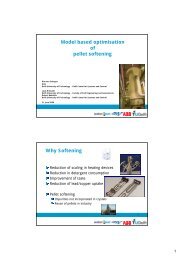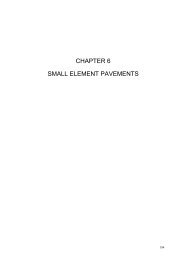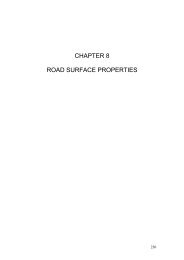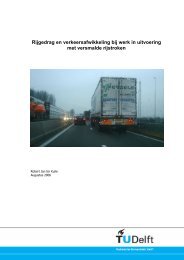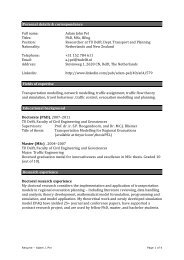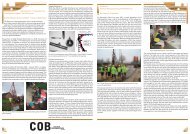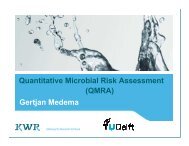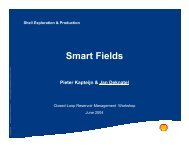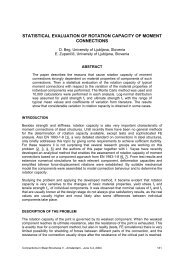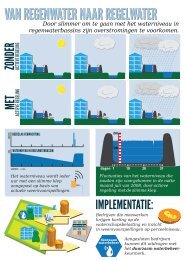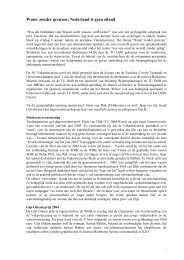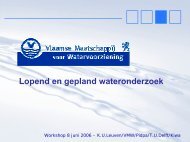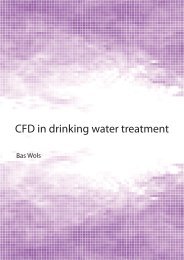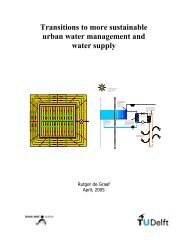Induction heating of electrically conductive porous asphalt ... - TU Delft
Induction heating of electrically conductive porous asphalt ... - TU Delft
Induction heating of electrically conductive porous asphalt ... - TU Delft
Create successful ePaper yourself
Turn your PDF publications into a flip-book with our unique Google optimized e-Paper software.
ARTICLE IN PRESS<br />
4 Q. Liu et al. / Construction and Building Materials xxx (2010) xxx–xxx<br />
<strong>heating</strong> samples were the same as the ones used to measure the electrical resistivity.<br />
The cylindrical samples cut from Gyratory specimens were used to avoid the<br />
problem <strong>of</strong> binder concentration on the surfaces <strong>of</strong> samples and to get a higher<br />
<strong>heating</strong> efficiency for that thinner samples mean less temperature difference between<br />
the top and the bottom <strong>of</strong> the samples. The distance between the coil <strong>of</strong><br />
the induction machine and the top surface <strong>of</strong> the <strong>heating</strong> sample was about<br />
32 mm. Each sample studied was heated for 3 min and its temperature change<br />
was measured with a 640 480 pixel, full color infrared camera.<br />
3. Results and discussions<br />
3.1. Effect <strong>of</strong> <strong>conductive</strong> fiber volume content on the electrical<br />
resistivity <strong>of</strong> <strong>porous</strong> <strong>asphalt</strong> concrete<br />
The effect <strong>of</strong> steel fiber (type 1) volume content on the resistivity<br />
<strong>of</strong> <strong>porous</strong> <strong>asphalt</strong> concrete samples is shown in Fig. 3. The resistivity<br />
<strong>of</strong> the samples shows three stages: high resistivity stage,<br />
with fiber volume content less than 10%; transit stage, with fiber<br />
volume content from 10% to 20%; and low resistivity stage, with fiber<br />
volume content higher than 20%. Samples with less than 10% <strong>of</strong><br />
fibers exhibited insulating behavior, with resistances higher than<br />
10 9 X m. During the transit stage (between 10% and 20% <strong>of</strong> fibers),<br />
the electrical resistivity <strong>of</strong> the sample suffered a sharp decrease<br />
from 10 9 X m to 4.7 10 4 X m. It was discovered that, for the steel<br />
fiber type 1, 20% fibers are needed to make the <strong>porous</strong> <strong>asphalt</strong> concrete<br />
<strong>electrically</strong> <strong>conductive</strong>.<br />
In addition, when drying the sample after cutting, it was found<br />
that plain samples, without steel fibers, glued a little bit to the<br />
plate bellow, showing drainage <strong>of</strong> binder in the sample. However,<br />
samples with steel fibers did not show this phenomenon, which<br />
shows that the steel fibers could prevent the drainage <strong>of</strong> binder.<br />
3.2. Effect <strong>of</strong> <strong>conductive</strong> fiber volume content on the indirect tensile<br />
strength <strong>of</strong> <strong>porous</strong> <strong>asphalt</strong> concrete<br />
The effect <strong>of</strong> steel fibers volume content on the indirect tensile<br />
strength (ITS) <strong>of</strong> <strong>porous</strong> <strong>asphalt</strong> concrete is shown in Fig. 4. The ITS<br />
<strong>of</strong> the plain <strong>porous</strong> <strong>asphalt</strong> concrete studied was 2.06 MPa. The ITS<br />
<strong>of</strong> <strong>porous</strong> <strong>asphalt</strong> concrete increased with the volume <strong>of</strong> steel fibers<br />
until a maximum <strong>of</strong> 2.62 MPa with a steel fibers content <strong>of</strong><br />
11%. Adding more fibers to the mixture results in a decrease <strong>of</strong><br />
the ITS, because too many fibers reduce the mastic film thickness,<br />
causing a bad adhesion between the <strong>asphalt</strong> components. Finally,<br />
samples with 20% <strong>of</strong> steel fibers (the one with highest electrical<br />
1,00E+10<br />
ITS MPa<br />
2.80<br />
2.60<br />
2.40<br />
2.20<br />
2.00<br />
1.80<br />
1.60<br />
0 5 10 15 20 25<br />
Fiber volume content %<br />
Fig. 4. Effect <strong>of</strong> steel fiber type 1 volume content on the ITS <strong>of</strong> <strong>porous</strong> <strong>asphalt</strong><br />
concrete.<br />
conductivity), had a maximum tensile strength <strong>of</strong> 2.03 MPa, close<br />
to that <strong>of</strong> the plain <strong>porous</strong> <strong>asphalt</strong> concrete.<br />
3.3. Electrically <strong>conductive</strong> mechanism in <strong>porous</strong> <strong>asphalt</strong> concrete<br />
Broken <strong>porous</strong> <strong>asphalt</strong> samples after indirect tensile test were<br />
observed under the microscope to check the fibers distribution.<br />
The <strong>conductive</strong> mechanism was explained according to the percolation<br />
theory [15]. Fiber distribution in samples with different contents<br />
<strong>of</strong> steel fibers is shown in Fig. 5. When 5% <strong>of</strong> steel fibers is<br />
added to the mixture, they are uniformly distributed and do not<br />
contact each other, having a similar resistivity to that <strong>of</strong> an <strong>asphalt</strong><br />
concrete sample without fibers. When more steel fibers are added<br />
to the mixture, they start contacting each other, which causes to a<br />
gradual decrease in the resistivity. If the fiber volume content<br />
reaches more than 10% (percolation threshold), the first <strong>conductive</strong><br />
paths are formed in the sample. This corresponds to a sharp decrease<br />
<strong>of</strong> resistivity. Beyond the percolation threshold, the <strong>conductive</strong><br />
network develops and spreads gradually in three dimensions<br />
with the increase <strong>of</strong> the volume content <strong>of</strong> the steel fibers. When<br />
the fiber volume content is more than 20%, steel fibers contact each<br />
other in all directions and many <strong>conductive</strong> networks and passages<br />
are formed, corresponding to a very low value <strong>of</strong> resistivity at<br />
which adding more steel fibers does not reduce the resistivity <strong>of</strong><br />
sample any more.<br />
3.4. Effect <strong>of</strong> bitumen content on the electrical resistivity <strong>of</strong> <strong>porous</strong><br />
<strong>asphalt</strong> concrete<br />
Resistivity Ω.m<br />
1,00E+08<br />
1,00E+06<br />
1,00E+04<br />
0 5 10 15 20 25<br />
Fiber volume content %<br />
Fig. 3. Effect <strong>of</strong> steel fiber type 1 volume content on the resistivity <strong>of</strong> <strong>porous</strong> <strong>asphalt</strong><br />
concrete.<br />
When fibers are added to the mixture, the thickness film <strong>of</strong><br />
mastic around the aggregates is reduced. This can have a negative<br />
effect on the mechanical properties <strong>of</strong> <strong>asphalt</strong> concrete pavements<br />
so, to ensure the durability <strong>of</strong> this <strong>porous</strong> <strong>asphalt</strong>, bitumen content<br />
needs to be increased. In this section, higher bitumen contents<br />
were used to check how the electrical conductivity <strong>of</strong> <strong>porous</strong> <strong>asphalt</strong><br />
concrete was affected. The fiber content was fixed at 20% in<br />
the mixture (for optimal electrical conductivity purpose) and the<br />
bitumen content was gradually increased from 4.5% to 5.4%. The effect<br />
<strong>of</strong> bitumen content on the electrical resistivity <strong>of</strong> <strong>porous</strong> <strong>asphalt</strong><br />
concrete samples is shown in Fig. 6. An increase in the<br />
bitumen content causes a reduction in the electrical resistivity <strong>of</strong><br />
<strong>porous</strong> <strong>asphalt</strong> concrete. Furthermore, ITS reductions from<br />
2.03 MPa to 1.40 MPa were also observed with the increase on<br />
bitumen content.<br />
Please cite this article in press as: Liu Q et al. <strong>Induction</strong> <strong>heating</strong> <strong>of</strong> <strong>electrically</strong> <strong>conductive</strong> <strong>porous</strong> <strong>asphalt</strong> concrete. Constr Build Mater (2010), doi:10.1016/<br />
j.conbuildmat.2009.12.019



